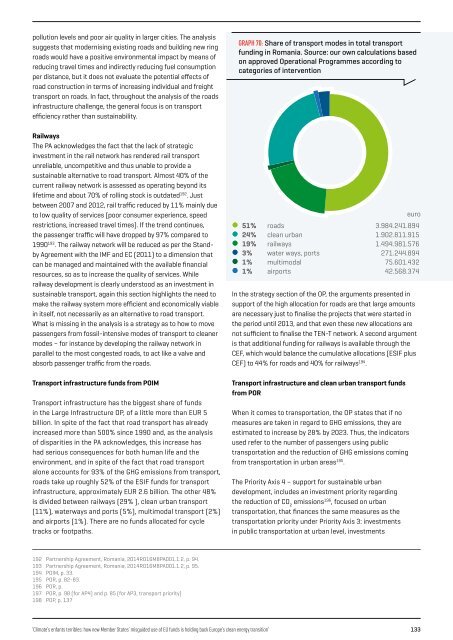ENFANTS TERRIBLES
enfants-terribles
enfants-terribles
You also want an ePaper? Increase the reach of your titles
YUMPU automatically turns print PDFs into web optimized ePapers that Google loves.
pollution levels and poor air quality in larger cities. The analysis<br />
suggests that modernising existing roads and building new ring<br />
roads would have a positive environmental impact by means of<br />
reducing travel times and indirectly reducing fuel consumption<br />
per distance, but it does not evaluate the potential effects of<br />
road construction in terms of increasing individual and freight<br />
transport on roads. In fact, throughout the analysis of the roads<br />
infrastructure challenge, the general focus is on transport<br />
efficiency rather than sustainability.<br />
GRAPH 70: Share of transport modes in total transport<br />
funding in Romania. Source: our own calculations based<br />
on approved Operational Programmes according to<br />
categories of intervention<br />
Railways<br />
The PA acknowledges the fact that the lack of strategic<br />
investment in the rail network has rendered rail transport<br />
unreliable, uncompetitive and thus unable to provide a<br />
sustainable alternative to road transport. Almost 40% of the<br />
current railway network is assessed as operating beyond its<br />
lifetime and about 70% of rolling stock is outdated 192 . Just<br />
between 2007 and 2012, rail traffic reduced by 11% mainly due<br />
to low quality of services (poor consumer experience, speed<br />
restrictions, increased travel times). If the trend continues,<br />
the passenger traffic will have dropped by 97% compared to<br />
1990 193 . The railway network will be reduced as per the Standby<br />
Agreement with the IMF and EC (2011) to a dimension that<br />
can be managed and maintained with the available financial<br />
resources, so as to increase the quality of services. While<br />
railway development is clearly understood as an investment in<br />
sustainable transport, again this section highlights the need to<br />
make the railway system more efficient and economically viable<br />
in itself, not necessarily as an alternative to road transport.<br />
What is missing in the analysis is a strategy as to how to move<br />
passengers from fossil-intensive modes of transport to cleaner<br />
modes – for instance by developing the railway network in<br />
parallel to the most congested roads, to act like a valve and<br />
absorb passenger traffic from the roads.<br />
Transport infrastructure funds from POIM<br />
Transport infrastructure has the biggest share of funds<br />
in the Large Infrastructure OP, of a little more than EUR 5<br />
billion. In spite of the fact that road transport has already<br />
increased more than 500% since 1990 and, as the analysis<br />
of disparities in the PA acknowledges, this increase has<br />
had serious consequences for both human life and the<br />
environment, and in spite of the fact that road transport<br />
alone accounts for 93% of the GHG emissions from transport,<br />
roads take up roughly 52% of the ESIF funds for transport<br />
infrastructure, approximately EUR 2.6 billion. The other 48%<br />
is divided between railways (29% ), clean urban transport<br />
(11%), waterways and ports (5%), multimodal transport (2%)<br />
and airports (1%). There are no funds allocated for cycle<br />
tracks or footpaths.<br />
euro<br />
51% roads 3.984.241.894<br />
24% clean urban 1.902.811.915<br />
19% railways 1.494.981.576<br />
3% water ways, ports 271.244.894<br />
1% multimodal 75.601.432<br />
1% airports 42.568.374<br />
In the strategy section of the OP, the arguments presented in<br />
support of the high allocation for roads are that large amounts<br />
are necessary just to finalise the projects that were started in<br />
the period until 2013, and that even these new allocations are<br />
not sufficient to finalise the TEN-T network. A second argument<br />
is that additional funding for railways is available through the<br />
CEF, which would balance the cumulative allocations (ESIF plus<br />
CEF) to 44% for roads and 40% for railways 194 .<br />
Transport infrastructure and clean urban transport funds<br />
from POR<br />
When it comes to transportation, the OP states that if no<br />
measures are taken in regard to GHG emissions, they are<br />
estimated to increase by 28% by 2023. Thus, the indicators<br />
used refer to the number of passengers using public<br />
transportation and the reduction of GHG emissions coming<br />
from transportation in urban areas 195 .<br />
The Priority Axis 4 – support for sustainable urban<br />
development, includes an investment priority regarding<br />
the reduction of CO 2<br />
emissions 196 , focused on urban<br />
transportation, that finances the same measures as the<br />
transportation priority under Priority Axis 3: investments<br />
in public transportation at urban level, investments<br />
192<br />
193<br />
194<br />
195<br />
196<br />
197<br />
198<br />
Partnership Agreement, Romania, 2014RO16M8PA001.1.2, p. 94.<br />
Partnership Agreement, Romania, 2014RO16M8PA001.1.2, p. 95.<br />
POIM, p. 33.<br />
POR, p. 82-83.<br />
POR, p.<br />
POR, p. 98 (for AP4) and p. 85 (for AP3, transport priority)<br />
POP, p. 137<br />
‘Climate’s enfants terribles: how new Member States’ misguided use of EU funds is holding back Europe’s clean energy transition’ 133


